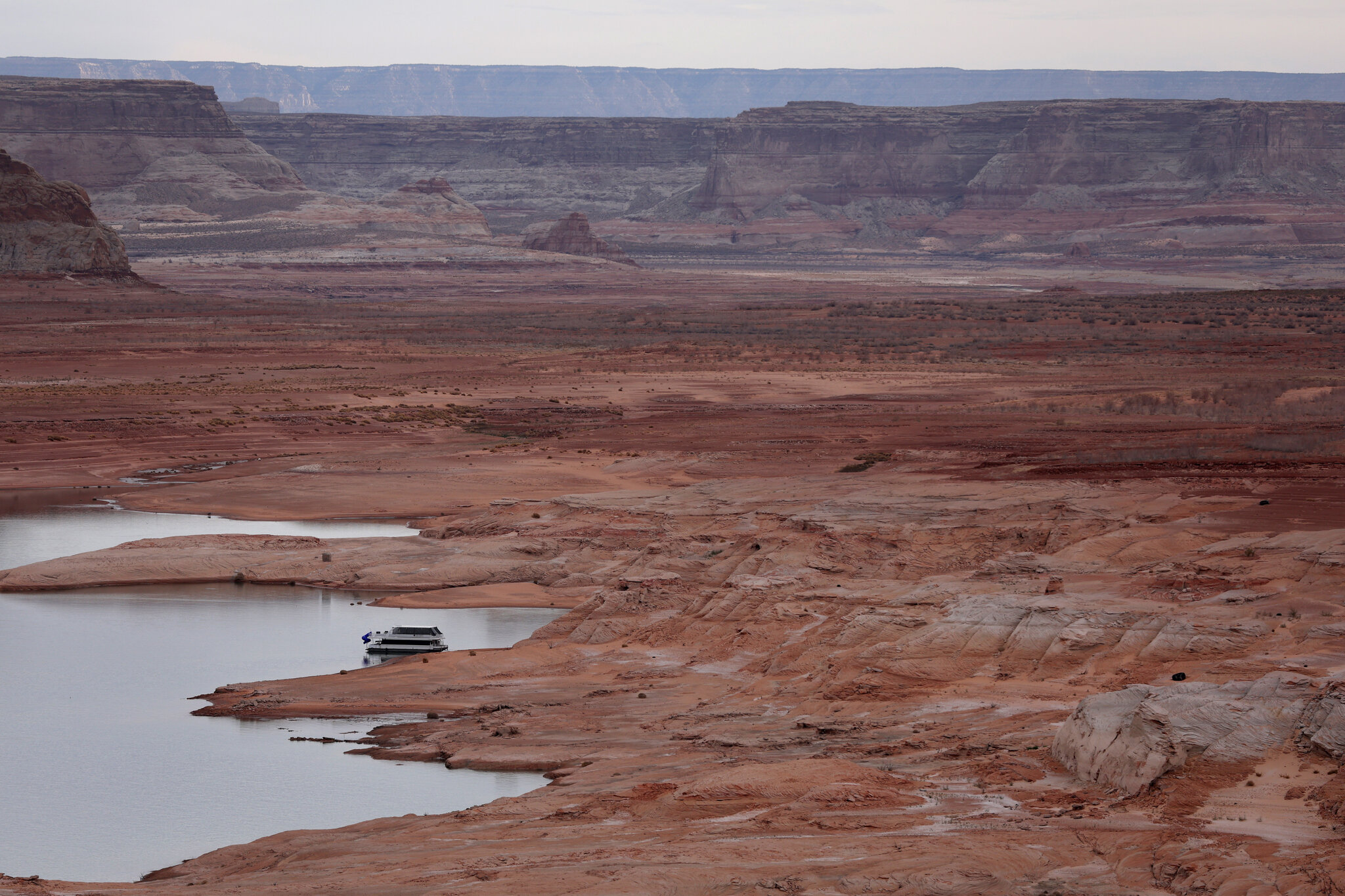California has given the federal government its own counterproposal for apportioning reductions of Colorado River water, saying a plan offered by six other states would disproportionately burden farms and cities in Southern California.
Water agencies that depend on the river submitted their proposal to the Biden administration on Tuesday, the same day that federal officials had set as a deadline for the Colorado River Basin states to reach agreement on how to prevent reservoirs from dropping to dangerously low levels.
The state put forward its proposal a day after Arizona, Colorado, Nevada, New Mexico, Utah and Wyoming released their alternative. A large portion of the cuts they proposed would be made by accounting for evaporation and other water losses along the lower portion of the river — a calculation that would translate into especially large reductions for California, which uses more Colorado River water than any other state.
The Colorado River flows near Hite Overlook, Utah, upstream from Lake Powell. (Carolyn Cole / Los Angeles Times)
“The six-state proposal directly and disproportionately impacts California,” said Wade Crowfoot, the state’s natural resources secretary. “It doesn’t seem like a constructive approach for some states to fashion a proposal that only impacts the existing water security and water rights of another state that’s not part of that proposal.”
Crowfoot said the other states had devised an approach that would go beyond anything established in the agreements and laws that govern how the Colorado River is managed and used. He said the proposal by California water agencies, in contrast, lays out practical and achievable changes that can be made starting this year to stabilize reservoir levels.
The state’s proposal builds on a previous commitment by four Southern California water agencies to cut water use by 400,000 acre-feet per year, a reduction of about 9%, through 2026. The federal government has asked the states to reduce their total usage by 2 million to 4 million acre-feet.
On top of the planned reductions in California and other states, the proposal calls for taking measures aimed at keeping reservoirs above certain levels, including making additional cuts on a tiered scale if the level of Lake Mead, the country’s largest reservoir, continues to decline toward critically low levels.
In the proposal letter, J.B. Hamby, chair of California’s Colorado River Board, said the state’s alternative “provides a realistic and implementable framework to address reduced inflows and declining reservoir elevations by building on voluntary agreements and past collaborative efforts in order to minimize the risk of legal challenge or implementation delay.”
California agencies including the Imperial Irrigation District and the Palo Verde Irrigation District, which deliver water to vast farmlands, have high-priority senior water rights dating back more than a century. California officials have insisted that these rights and the existing law of the river must be upheld in any plan for reducing water use.
“California is not wavering from our legal position,” Hamby said. “We continue to look forward to developing a seven-state consensus if possible, but in the absence of that, it defaults to the law of the river.”
If any legal disputes erupt, that could complicate efforts to come up with solutions. The states are submitting their proposed alternatives as the Interior Department and the Bureau of Reclamation begin a review process to revise the current rules for dealing with Colorado River shortages.
The Colorado River flows near Hite Overlook, Utah, upstream from Lake Powell. (Carolyn Cole / Los Angeles Times)
Hamby said California is focused on “practical solutions that can be implemented now to protect volumes of water in storage without driving conflict and litigation.”
“As of this point in time, we were not able to reach that consensus, but we hope to achieve that moving forward,” Hamby said. “We need to be able to reach consensus among the seven basin states to come up with voluntary approaches where each state is comfortable with the direction.”
Even after the federal government’s deadline, managers of water agencies have more talks scheduled to continue negotiating.
The Colorado River, which supplies cities, farming areas and tribal nations from the Rocky Mountains to the U.S.-Mexico border, has been pushed to a breaking point by chronic overuse, drought and the effects of global warming.
Over the last 23 years, the watershed has been desiccated by the worst drought in centuries, which has been intensified by rising temperatures.
Lake Mead and Lake Powell now sit about three-fourths empty. And although the Rocky Mountains have seen an above-average amount of snow so far this winter, it’s not nearly enough to lift the reservoirs out of the severe water deficit.
Federal officials in June called for the seven states to come up with plans to reduce water diversions by approximately 15% to 30%. But negotiations among the states grew acrimonious and didn’t produce a deal.
In October, the Biden administration announced plans to revise the current rules for dealing with shortages and to pursue a new agreement for major reductions in water use.
Compatability statement
This webpage is fully compatible desktops displays, large displays, and tablet displays. The header and body will stretch the fill the width of the screen, but if the width decreases too much (i.e. on a mobile screen), the header text will overflow the header image, as the header image has a fixed height. At some point, the text will also no longer be readable since it will be too narrow.
The text is formatted into two columns, which remains the case even on screens with small widths. Ideally, I would change the number of columns to one once a certain width breakpoint is reached.
Furthermore, any hover changes will not be viewable on mobile, since there's no such thing as hovering on mobile.



